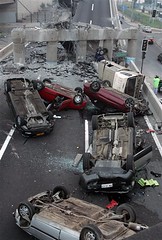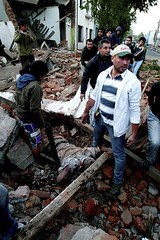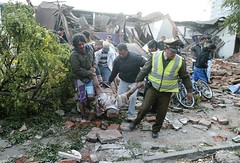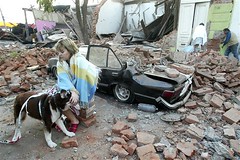The National Disaster Coordinating Council (NDCC) has already placed two provinces in Davao Region -- Davao Oriental and Davao del Sur -- under tsunami alert, as well as the provinces of Ilocos Norte, Isabela, Quezon, Aurora, Camarines Norte, Camarines Sur, Albay, Catanduanes, Sorsogon, Northern Samar, Eastern Samar, Leyte, Southern Leyte, Surigao del Norte and Surigao del Sur.
Richard Villacorte, Davao Oriental’s City of Mati administrator, said Saturday evening that they already issued alert warnings to all barangays and local responder groups and had checked readiness of the police, coast guard and the fire department and other agencies in case a tsunami strikes.
The NDCC estimated first tsunami waves to arrive in the country at 1 p.m. Sunday.
Solidum advised the people to await further notice of a possible tsunami, but said the Phivolcs is not recommending evacuations yet.
Early Sunday four tsunami waves of about six feet (two meters) hit the Marquesas Islands of French Polynesia, located in the southern Pacific Ocean, extensively damaging part of the coast. The first wave passed Tahiti with no effects.
On Chatham Islands, 312 miles (500 kilometers) east of New Zealand, officials reported an eight-inch (20 centimeter) wave washed ashore there.
Tonga and the Cook Islands in the south Pacific Ocean were evacuating coastal areas as the waves were expected to hit later in the morning. On Tahiti, traffic was banned on roads less than 500 meters (550 yards) from the sea. Residents on islands of low elevation were told to get to higher ground.
A tsunami triggered by the Chilean earthquake raced across the Pacific Ocean, threatening Hawaii as it rushed toward the U.S. West Coast and hundreds of islands from the bottom of the planet to the top.
Sirens blared in Hawaii to alert residents to the potential waves. Nine small planes equipped with loudspeakers flew along the shoreline, warning beachgoers.
The first waves in Hawaii could hit at any moment and measure roughly eight feet (2.5 meters) at Hilo. Most Pacific Rim nations did not immediately order evacuations, but advised people in low-lying areas to be on the lookout.
Officials in Japan and Australia also warned a tsunami from the 8.8-magnitude earthquake that hit Chile’s capital for a minute and a half early Saturday was likely to hit Asian, Australian, and New Zealand shores within 24 hours.


The Pacific Tsunami Warning Center in Hawaii issued a tsunami warning that included the Philippines, Taiwan, Indonesia, and many island nations in the Pacific, while a lower-level advisory was issued for northern Pacific locations, including the US West Coast and Alaska.
"Sea-level readings confirm that a tsunami has been generated which could cause widespread damage," the center said in a bulletin after the quake. "Authorities should take appropriate action to respond to this threat."
Earlier, Chilean President Michele Bachelet said a huge wave had already reached a populated area in the Robinson Crusoe Islands, 660 kilometers off the Chilean coast.
But the Pacific Tsunami Warning Center noted that the first waves after a quake are not necessarily the largest. It said tsunami wave heights are difficult to predict because they can vary significantly along a coast due to the local topography.
Earthquakes across the Pacific have had deadly effects on Asia in the past.
A tsunami after a magnitude-9.5 quake that struck Chile in 1960, the largest earthquake ever recorded, killed about 140 people in Japan, 61 in Hawaii and 32 in the Philippines. That tsunami was about 3.3 to 13 feet (one to four meters) in height, Japan's Meteorological Agency said.
The tsunami from Saturday's quake was likely to be much smaller because the quake itself was not as strong.
Japanese public broadcaster NHK quoted earthquake experts as saying the tsunami would likely be tens of centimeters (inches) high and reach Japan in about 22 hours. A tsunami of 28 centimeters (11 inches) was recorded after a magnitude-8.4 earthquake near Chile in 2001.
The Meteorological Agency said it was still investigating the likelihood of a tsunami from the magnitude-8.8 quake and did not issue a formal coastal warning.
Australia, meanwhile, was put on a tsunami watch.
The Joint Australian Tsunami Warning Center issued a warning for a "potential tsunami threat" to New South Wales state, Queensland state, Lord Howe Island and Norfolk Island. Any potential wave would not hit Australia until Sunday morning local time, it said.
Death toll

The earthquake that struck early Saturday in central Chile shook the capital for a minute and a half.
As of this posting Sunday, Chile quake death toll rises to 214 and is likely to increase numbers.
"It has been a devastating earthquake," Interior Minister Edmundo Perez Yoma told reporters.
Bachelet said the death toll was at 78 and rising, but officials had no information on the number of people injured. She declared a "state of catastrophe" in central Chile.
"We have had a huge earthquake, with some aftershocks," Bachelet said from an emergency response center. She urged Chileans not to panic.
"Despite this, the system is functioning. People should remain calm. We're doing everything we can with all the forces we have. Any information we will share immediately," she said.
In the two and a half hours following the 90-second quake, the US Geological Survey reported 11 aftershocks, five of them measuring 6.0 or above.
Bachelet urged people to avoid traveling, since traffic lights are down, to avoid causing more fatalities.
Damages

In the capital, Santiago airport was shut down and will remain closed for at least the next 24 hours, airport director Eduardo del Canto said.
The passenger terminal has suffered major damage, he told Chilean television in a telephone interview.
There were also power outages in Santiago and Conception, television report said.
Television images show smashed windows, partially collapsed ceilings and pedestrian walkways destroyed.
Also, Chilean television showed images of destroyed buildings and damaged cars, with rubble-strewn streets. Dozens of people were seen roaming through the streets, including some wheeling suitcases behind them. There was a fire burning in one street with people sitting nearby trying to keep warm.
The quake hit 200 miles (325 kilometers) southwest of Santiago, at a depth of 22 miles (35 kilometers) at 3:34 a.m. (0634 GMT; 1:34 a.m. EST), the US Geological Survey reported.
The epicenter was just 70 miles (115 kilometers) from Concepcion, Chile's second-largest city, where more than 200,000 people live along the Bio Bio river, and 60 miles from the ski town of Chillan, a gateway to Andean ski resorts that was destroyed in a 1939 earthquake.
At least 33 aftershocks were reported, the strongest one had a magnitude of 6.9.
Marco Vidal, a program director for Grand Circle Travel traveling with a group of 34 Americans, was on the 19th floor of the Crown Plaza Santiago hotel when the quake struck.
"All the things start to fall. The lamps, everything, was going on the floor. And it was moving like from south to north, oscillated. I felt terrified," he said.
Cynthia Iocono, from Linwood, Pennsylvania, said she first thought the quake was a train. "But then I thought, oh, there's no train here. And then the lamps flew off the dresser and my TV flew off onto the floor and crashed."
"It was scary, but there really wasn't any panic. Everybody kind of stayed orderly and looked after one another," Iocono said.
In Santiago, modern buildings are built to withstand earthquakes, but many older ones were heavily damaged, including the Nuestra Senora de la Providencia church, whose bell tower collapsed. An apartment building's two-level parking lot also flattened onto the ground floor, smashing about 50 cars whose alarms and horns rang incessantly. A bridge just outside the capital also collapsed, and at least one car flipped upside down.
In the coastal city of Vina del Mar, the earthquake struck just as people were leaving a disco, Julio Alvarez told Radio Cooperativa in Santiago. "It was very bad, people were screaming, some people were running, others appeared paralyzed. I was one of them."
Bachelet said she was declaring a "state of catastrophe" in three central regions of the country, and that while emergency responders were waiting for first light to get details, it was evident that damage was extensive.
She said Chile has not asked for assistance from other countries yet.
As of this posting Saturday, the Pacific Tsunami Warning Center has called for "urgent action to protect lives and property" in Hawaii, while state seismologists in the Philippines and other Asian countries are closely monitoring over the possibility of destructive waves reaching their shore. (AP/PNA/Ben O. Tesiorna of Sun.Star Davao/Sunnex)
